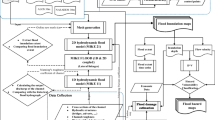Abstract
Accurate built-up information is imperative for loss estimation and disaster management after the occurrence of catastrophic events such as earthquake, tornado, tsunami and flood. These catastrophic events leave behind a trail of mass destruction with property and human losses amounting to millions. Once a natural disaster hits a region, built-up information is required within a short span of time for disaster management. Nowadays, earth observation satellite imagery serves as a promising source to extract the land use / land cover classes. However, the automatic extraction of urban built-up from remote sensing data is a known challenge in the remote sensing community. The normalized difference built-up index (NDBI) algorithm has been recognized as an effective algorithm for automatic built-up identification from medium spatial and spectral resolution satellite images. Few researchers have modified this algorithm and proposed new quantitative expressions for the built-up index. In this paper, three built-up index based, unsupervised built-up extraction algorithms have been reviewed and compared. An automated kernel-based probabilistic thresholding algorithm is used to assort the built-up index values, obtained from modified built-up index algorithms, into built-up and non built-up regions for enhancing the efficiency of the built-up detection process. Qualitative assessment of these algorithms involves computation of several parameters including recently developed parameters like allocation disagreement and quantity disagreement, and classical parameters such as error of omission, error of commission and overall accuracy. This paper presents a case study where the algorithms have been implemented on Landsat-5 Thematic Mapper (TM) image of the city of Delhi and its surrounding areas for detection of built-up regions automatically.


Similar content being viewed by others
References
Chen, J., Peng, G., He, C., Pu, R., & Shi, P. (2003). Land-use/land-cover change detection using improved change vector analysis. Photogrammetric Engineering and Remote Sensing, 69(4), 369–379.
Congalton, R. (1991). A review of assessing the accuracy of classification of remotely sensed data. Remote Sensing of Environment, 37(1), 35–46.
He, C., Shi, P., Xie, D., & Zhao, Y. (2010). Improving the normalized difference built-up index to map urban built-up areas using a semiautomatic segmentation approach. Remote Sensing Letters, 1(4), 213–221.
Jieli, C., Manchun, L. Yongxue, L., Chenglei, S. & Wei, H. (2010). Extract residential areas automatically by new built-up index. 2010 18th International Conference on Geoinformatics (Geoinformatics 2010).
Kontoes, C. C. (2008). Operational land cover change detection using change vector analysis. International Journal of Remote Sensing, 29(16), 4757–4779.
Pontius, R. G. J., & Millones, M. (2011). Death to Kappa: birth of quantity disagreement and allocation disagreement for accuracy assessment. International Journal of Remote Sensing, 32(15), 4407–4429.
Stuckens, J., Coppin, P. R., & Bauer, M. E. (2000). Integrating contextual information with per- pixel classification for improved land cover classification. Remote Sensing of Environment, 71(3), 282–296.
Thomas, N., Hendrix, C., & Congalton, R. G. (2003). A comparison of urban mapping methods using high-resolution digital imagery. Photogrammetric Engineering and Remote Sensing, 69(9), 963–972.
Varshney, A. (2013). Improved NDBI differencing algorithm for built-up regions change detection from remote-sensing data: an automated approach. Remote Sensing Letters, 4(5), 504–512.
Varshney, A., Arora, M. K., & Ghosh, J. K. (2012). Median change vector analysis algorithm for land use land cover change detection from remote sensing data. Remote Sensing Letters, 3(7), 605–614.
Xu, H. (2008). A new index for delineating built-up land features in satellite imagery. International Journal of Remote Sensing, 29(14), 4269–4276.
Zha, Y., Gao, Y., & Nt, S. (2003). Use of normalized difference built-up index in automatically mapping urban areas from TM imagery. International Journal of Remote Sensing, 24(3), 583–594.
Zhang, J., & Foody, G. M. (2001). Fully-fuzzy supervised classification of sub-urban land cover from remotely sensed imagery: Statistical and artificial neural network approaches. International Journal of Remote Sensing, 22(4), 615–628.
Zhang, Q., & Wang, J. (2003). A rule-based urban land use inferring method for fine resolution multispectral imagery. Canadian Journal of Remote Sensing, 29(1), 1–13.
Author information
Authors and Affiliations
Corresponding author
About this article
Cite this article
Varshney, A., Rajesh, E. A Comparative Study of Built-up Index Approaches for Automated Extraction of Built-up Regions From Remote Sensing Data. J Indian Soc Remote Sens 42, 659–663 (2014). https://doi.org/10.1007/s12524-013-0333-9
Received:
Accepted:
Published:
Issue Date:
DOI: https://doi.org/10.1007/s12524-013-0333-9




